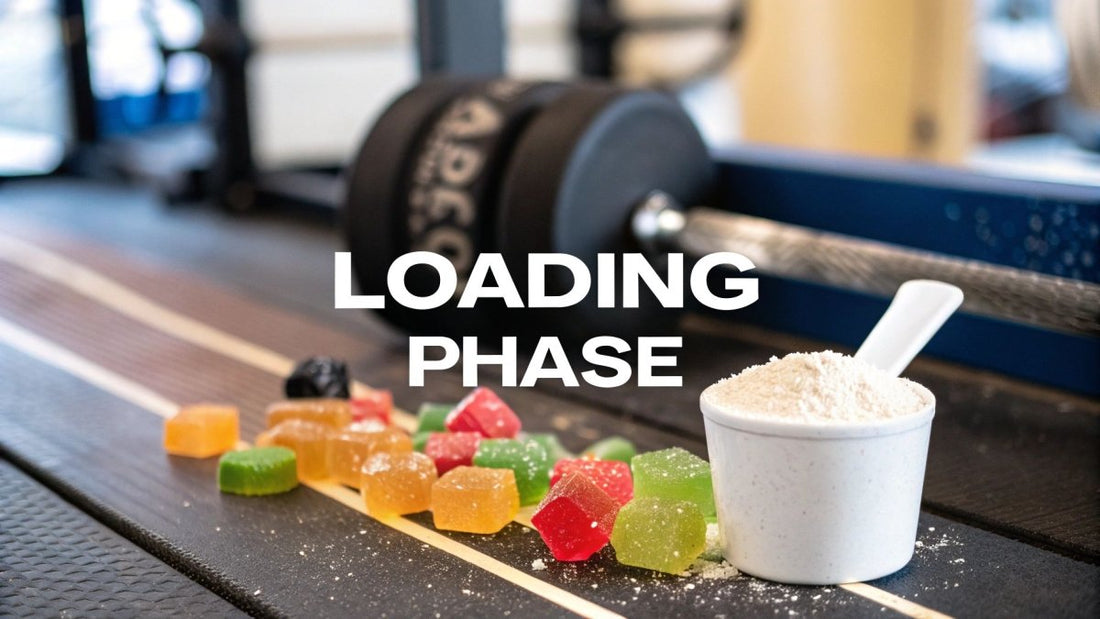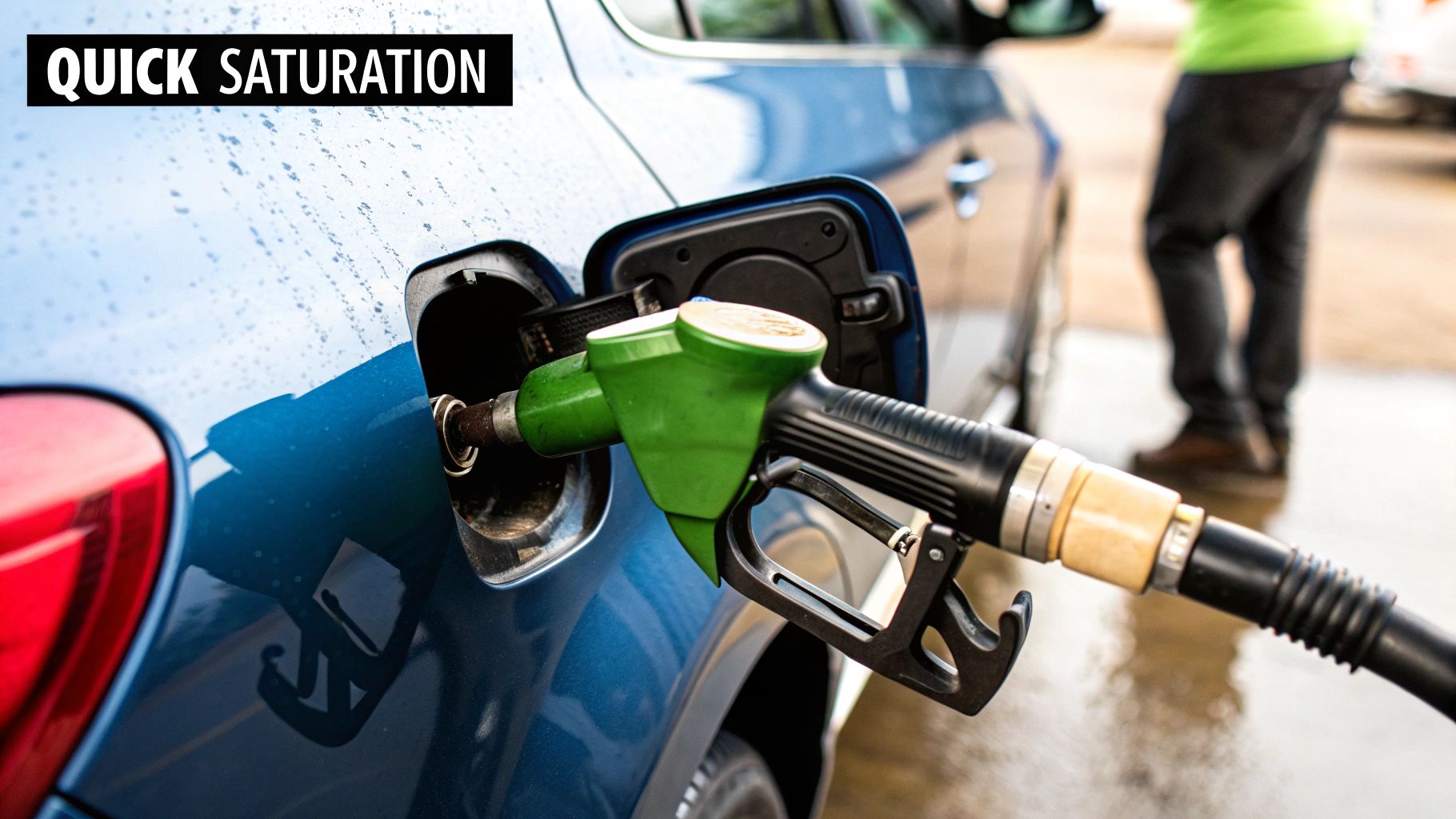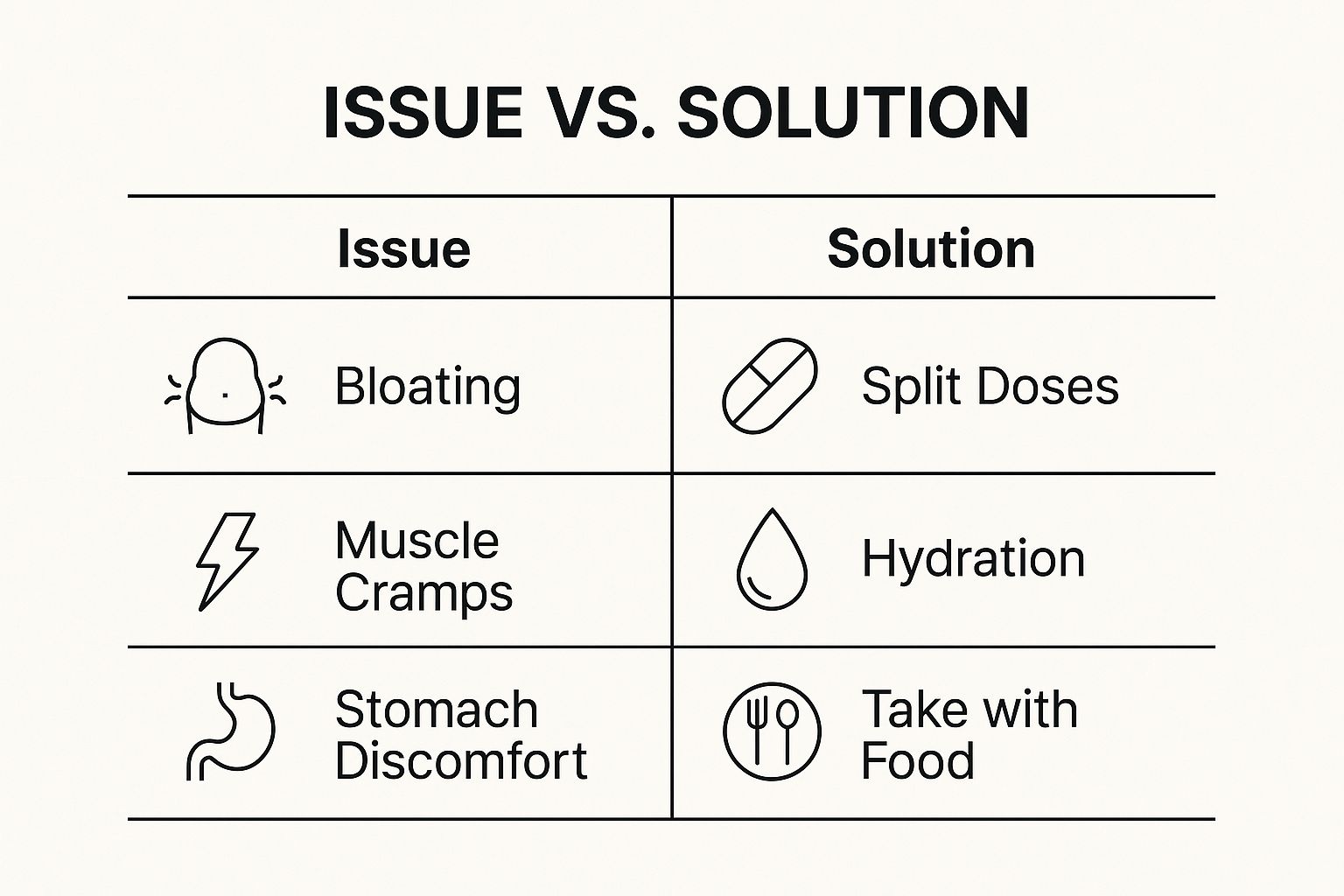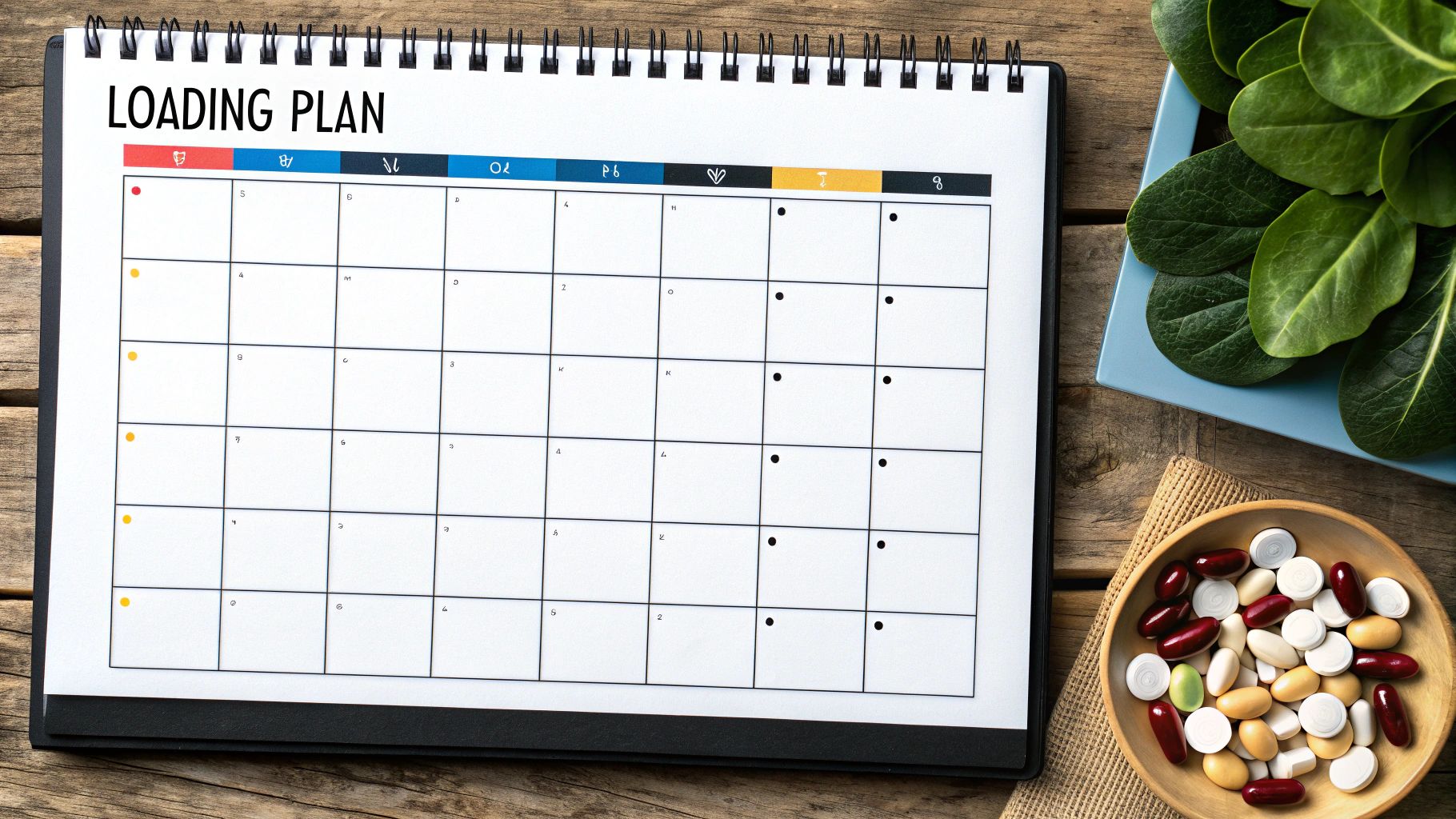
A Guide to the Loading Phase of Creatine
Share
When you first start with creatine, you’ll often hear about a "loading phase." It's essentially a short-term strategy to fast-track your results. Instead of taking a small amount every day and waiting, you take a higher dose—usually 20 grams a day for 5-7 days—to saturate your muscles as quickly as possible.
Think of it as the express lane to creatine’s benefits. You can start seeing improvements in strength and power in about a week, rather than the month it might take with a standard dose.
Understanding the Creatine Fast Track
Imagine your muscles are like a dry sponge and creatine is the water. You could let that sponge slowly soak up water from a dripping faucet. Eventually, it would get completely saturated. That's what happens when you take a standard 3-5 gram maintenance dose—it gets the job done, but it takes about three to four weeks.
A creatine loading phase is like holding that same sponge under a fully open tap. You’re drenching it. By flooding your system with a higher amount of creatine for a short burst, you dramatically speed up how quickly your muscles fill up.

The Standard Loading Protocol
So, what does this actually look like in practice? The most common and research-backed protocol is pretty simple.
- Daily Dose: Aim for a total of 20 grams of creatine each day.
- Split Servings: Don't take it all at once. Split it into four 5-gram servings spread throughout the day—think morning, midday, afternoon, and evening.
- Duration: Stick with this high-dose plan for 5 to 7 days in a row.
Breaking up the dose helps your body absorb it better and avoids the stomach discomfort that can come with taking a large amount all at once. This method has been shown to boost creatine stores inside your muscles by a hefty 20% to 40% in just one week. If you're curious, you can read the full research about these findings to see the science behind it.
To make it even clearer, here’s a quick breakdown of what a standard loading phase involves.
Creatine Loading Protocol at a Glance
| Component | Standard Protocol | Purpose |
|---|---|---|
| Daily Intake | 20 grams | To rapidly increase muscle creatine concentration. |
| Dosing Schedule | Four 5-gram servings | Enhances absorption and minimizes potential GI distress. |
| Duration | 5-7 consecutive days | The time needed to achieve full muscle saturation. |
| Follow-up | 3-5 grams daily | To maintain elevated creatine levels after loading. |
As the table shows, the process is straightforward and designed for maximum efficiency.
The whole point of the loading phase is to quickly top off your body's phosphocreatine stores. These stores are your muscles' high-energy reserve, giving them immediate fuel for explosive power during heavy lifts or intense sprints.
By front-loading your intake, you fill this "fuel tank" in a matter of days, not weeks. Once the loading phase is over, you simply drop down to a daily maintenance dose of 3-5 grams to keep those muscle stores full and hang on to your performance gains.
How Rapid Muscle Saturation Actually Works
To get why the creatine loading phase works so well, we need to peek inside your muscles. Think of every muscle cell as having a tiny, built-in battery called adenosine triphosphate, or ATP. This is the raw fuel for any quick, explosive movement—that first big push on a bench press or a dead-start sprint.
The catch? Your body only keeps enough ATP on hand for a few seconds of maximum effort. Once that's gone, your power output nose-dives. This is where creatine steps in and completely changes the game.
Recharging Your Muscle Batteries
Imagine your ATP is a phone battery that dies after just a few minutes of use. Creatine, which your body stores in your muscles as phosphocreatine, is like a high-speed portable charger. It instantly donates a phosphate molecule to "recharge" depleted ATP, letting you push harder for longer.
A loading phase is designed to flood your system, boosting your muscles' phosphocreatine reserves by 20-40% in less than a week. Your internal power bank isn't just full—it's overcharged and ready for anything. This means more reps in the tank, quicker recovery between sets, and more force behind every movement.
Essentially, loading doesn’t give you new energy; it dramatically improves your ability to regenerate the high-octane energy you already have, right when you need it most.
By temporarily taking higher doses, you push past your body's normal absorption rate and fully saturate your muscles in just days, not the usual weeks. This puts you on the fast track to seeing real results. For a deeper look into the timeline, explore our guide on how long it takes for creatine to work.
This rapid saturation is what you feel in the gym as a noticeable jump in strength and power right after the loading week. You’re not just taking a supplement; you’re fundamentally upgrading your body’s energy system to handle more intense training. It’s the difference between a standard battery and one built for high performance.
The Real Benefits of a Creatine Loading Phase
So, what's the actual payoff for doing a loading phase? We're talking about tangible results you can feel in the gym, often in less than a week. It’s not just about theory; it’s about real-world performance boosts.
The first thing you'll likely notice is a jump in raw power and strength. With your creatine stores completely topped off, your muscles have the fuel they need for those explosive, all-out efforts. Think squats, deadlifts, and bench presses—you'll be able to generate more force, which is exactly how you smash through plateaus and set new PRs.

This boost in energy also means better endurance within a set. You might find you can grind out one or two more high-quality reps before your muscles give out. That extra work is a potent signal for long-term muscle growth.
Understanding the Rapid Weight Gain
Don't be surprised if the number on the scale jumps up quickly when you start loading. This isn't fat. It’s simply creatine doing its job by pulling water into your muscle cells, a process known as cellular hydration.
This initial weight gain is actually a great sign that the creatine is working. Studies consistently show a bump in body mass after a loading phase of creatine, primarily from water and an increase in fat-free mass. If you want to get into the weeds, you can learn more about these findings from controlled trials.
This cell swelling isn't just for show, either. It makes your muscles look fuller, but it may also trigger anabolic signals that tell your body to kickstart muscle repair and growth.
This makes the loading phase a powerful tool for anyone looking for a fast track to better performance. Of course, to make the most of it, you need to back it up with solid nutrition. Pairing creatine with a high-protein diet is key for muscle gain, and using one of the best high-protein meal delivery services can make hitting your daily targets a whole lot easier.
Potential Side Effects and How to Avoid Them
So, is the creatine loading phase all upsides? Not always. While it’s a proven shortcut to maxing out your muscles' creatine stores, that initial high dose can sometimes stir up a bit of trouble in your gut.
The most common complaints are things like bloating, stomach cramps, or a bit of nausea. This usually happens because creatine is hydrophilic—it loves water and pulls it into your system. When you suddenly introduce a large amount, your digestive system can get a little overwhelmed. It’s a common, but thankfully temporary, hiccup.
The good news? These issues are almost always mild and pretty easy to sidestep. You don't have to just grit your teeth and bear it.
Managing and Preventing Discomfort
The secret to a comfortable loading phase is all about how you manage the dosage. Instead of chugging all 20 grams in one go, try a smarter approach.
- Split your doses: Break the 20 grams into four smaller 5-gram servings spread throughout the day. Think breakfast, lunch, pre-workout, and dinner.
- Take it with food: Having your creatine with a meal provides a nice buffer for your stomach, which can make a world of difference.
- Hydrate, hydrate, hydrate: This is the big one. Staying well-hydrated is non-negotiable. Since creatine is pulling water into your muscles, you need to drink more to compensate. This helps your body process the creatine efficiently and keeps dehydration-related cramps at bay.
This infographic lays out the common issues and the simple fixes.

As you can see, the solutions are just simple tweaks to your routine, not major overhauls.
It’s also crucial to clear the air about some old myths. Creatine is not an anabolic steroid—not even close. And for people with healthy kidneys, decades of research have consistently shown it to be safe. If you're curious and want to dive deeper into the science, you can learn about the effects of creatine on kidney health in our detailed guide. Knowing the facts lets you supplement with confidence and focus on what matters: hitting your goals.
To Load or Not to Load? Picking Your Creatine Strategy
So, should you kick things off with a creatine loading phase or just ease into a daily maintenance dose? The honest answer is, it really depends on what you're trying to achieve and how fast you want to get there. There’s no right or wrong here, just what’s right for you.
The whole decision boils down to one thing: speed.
Think of it like this: if you have a competition or a big event just a couple of weeks away, loading creatine is like taking the express train. You'll get to your destination—fully saturated muscles and performance benefits—much faster. But if you're in it for the long haul and focused on steady, consistent progress, the slower, local-train approach of a standard maintenance dose works just fine.
Ultimately, you're weighing rapid results against the potential for a little short-term discomfort.
Comparing the Two Paths
The main selling point of the loading phase is how fast it works. By front-loading with higher doses, you can max out your muscle's creatine stores in under a week. Some studies have shown noticeable strength gains in as little as six days.
On the other hand, starting with a simple maintenance dose will get you to the exact same place. The catch? It just takes longer. You're looking at about 28 days to reach full saturation with this method.
The tradeoff for that speed is a higher chance of some minor side effects, mostly an upset stomach or some bloating. Taking a massive 20 grams a day can be a bit of a shock to the system for some people. Sticking with the smaller 3-5 gram daily dose is much gentler and almost entirely sidesteps that risk.
It's a strategic choice. Do you want the express route to faster results, even if the ride is a bit bumpy? Or do you prefer the scenic route—smoother, but a little longer to reach the same destination?
To help you decide, let's put these two strategies head-to-head. Seeing the key differences laid out clearly can make it much easier to pick the path that best suits your body and your goals.
Creatine Loading vs Standard Maintenance Dose
| Feature | Loading Phase (20g/day for 5-7 days) | Maintenance Dose (3-5g/day) |
|---|---|---|
| Time to Results | Super fast (about 5-7 days) | Much slower (around 3-4 weeks) |
| Side Effect Risk | Higher (potential for bloating or GI upset) | Very low |
| Convenience | Less convenient (requires multiple doses per day) | Super convenient (just one dose a day) |
| Best For | Athletes needing a quick performance boost | General fitness, long-term use, sensitive stomachs |
After weighing the pros and cons, you can confidently choose the protocol that makes the most sense for your lifestyle and timeline. One path gets you there faster, the other is a bit easier on the system—but both lead to the same great results in the end.
Your Step-by-Step Guide to a Perfect Loading Phase
So, you're ready to kickstart your creatine journey with a loading phase? Fantastic. Let's walk through the proven, no-nonsense protocol to make sure you get it right from day one.

The standard, research-backed method is simple: take 20 grams of creatine every day for 5 to 7 days. The golden rule here is don't try to chug all 20 grams at once. That's a surefire way to upset your stomach.
Instead, the smart approach is to break that daily total into four smaller, 5-gram servings. This makes it much easier for your body to absorb and is way kinder to your digestive system.
The Ideal Dosing Schedule
Timing is everything. To get the best results, you'll want to space your doses out evenly across the day. A simple schedule that works for most people looks like this:
- Morning: Take your first 5 grams with breakfast.
- Midday: Have your second serving with your lunch.
- Around Your Workout: Take the third dose either just before or right after you train.
- Evening: Finish up with the final 5 grams with your dinner.
Pro tip: Taking each dose with a meal that has some carbs and protein can give absorption a nice little boost. If you want to dial in your exact numbers, our creatine dosage calculator can give you a personalized plan.
Don't forget the most critical piece of the puzzle: hydration. Creatine pulls water into your muscles to work its magic, so you absolutely must drink more water than usual. This is non-negotiable for both performance and avoiding side effects like cramping.
After that initial 5-7 day loading period, you're all set. You can then drop down to a simple "maintenance dose" of just 3-5 grams per day. This is all you need to keep your muscles topped off and hold onto those hard-earned strength and performance gains.
Your Creatine Loading Questions, Answered
Let's tackle some of the most common questions people have about creatine loading. Getting these details straight will help you figure out the best way to get started and feel confident in your plan.
Do I Really Have to Do a Loading Phase?
Nope, it's not a must-do. You can absolutely get your muscles fully saturated with creatine by just taking a smaller dose—think 3-5 grams—every day. The only catch is that it takes longer, usually about 3 to 4 weeks to see the full effects.
Think of the loading phase as a shortcut. It gets you to that same saturation point in about a week. It’s for people who want to see results faster, but it’s not the only way to get there.
What Happens If I Miss One of My Doses?
Don't sweat it. If you miss one of your 5-gram servings during the loading week, just get back on track with your next scheduled dose.
There's no need to double up to "make up" for it. One missed dose isn't going to throw everything off. The main thing is to be generally consistent throughout the week.
The real key to loading is splitting that 20-gram daily total into four smaller 5-gram doses. Spreading them out makes it easier for your body to absorb and helps you avoid any potential stomach issues.
And a pro-tip? While timing isn't everything, taking one of those doses after your workout with some carbs and protein can give you a little extra edge in muscle recovery and uptake. But at the end of the day, just being consistent is what will deliver the results.
Tired of mixing messy powders? If you want a simpler, tastier way to get your daily creatine, check out the gummies from Smash.com. They make it easy to hit your goals, whether you're loading up or just maintaining.